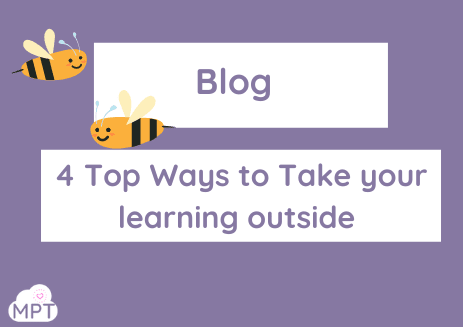Whether you are a full-blown Forest School enthusiast or an outdoor learning newbie, we all get stuck from time to time with ideas! Let us inspire you with 4 new nature-based, sustainable ideas that will help you create engaging lessons, full of cross-curricular links and depth of knowledge.
Bamboo Canes
- Bamboo-tastic Shape
Bamboo canes are a great outdoor resource because they’re equal in length and are perfect for outdoor maths! Ensure you remind children before using bamboo canes that ‘Sticks stay low they tickle our toe, if they go high, they poke us in the eye! Then ask the children to create a triangle. How many sticks will you need? How many sides does a triangle have? Once the children have made the triangle can they now identify how many corners it has by placing a fallen leaf on each corner? Invite the children to then look around their outdoor space and fill the triangle with any bits of nature that also have a similar shape to a triangle. Repeat this with other basic 2D shapes such as a square, rectangle and circle.
Top Tip: Store your bamboo outside to save you time. Use three tyres stacked up, one on top of the other and store the bamboo sticks in there.
- Natural phoneme frames
Bamboo is an incredibly versatile resource and whatever worksheet you do indoors can be visualised outdoors using bamboo. Involve the children and ask them to make a 3-box phoneme frame. Using fallen leaves and rocks, hand our marker pens and ask the children to write out the initial letter for the word c-a-t and to place this in the first phoneme. What letter comes next? Shall we also write this sound on a rock or leaf? What is the last sound we hear? Let’s pop that on a rock or leaf and add it to the third phoneme box. Invite the children to then jump on each sound, segmenting and blending the words as we go. Try more CVC words then move on to a four-box frame. This can also make a great outdoor continuous provision activity for children to play with and create their own words.
Top Tip: Although this activity appears to be a literacy task it also is embedding a lot of PSED and PD, as outdoor learning generally does. The children will have to do lots of fine motor and gross motor work. Negotiating, turn-taking and sharing as they work together. Plus we do know playing with nature, and being outside is all good for self-regulating and feeling great.
Upcycling Containers
- The rainy day capacity challenge
It is a great idea from now on, to start collecting bottles and containers such as yoghurt pots of various sizes. This activity only works on rainy days! Invite the children to get in their waterproofs and then venture outside with a yoghurt pot. With a bucket in the middle of your outdoor space. This will be your ‘main’ container which the children will pour their water amounts into. Ask the children to then catch the rain droplets and then pour what they have collected into the main bucket. Ask the children for different amounts, for instance. Bring me your yoghurt pot when it is half full, nearly full, full or just a little full. At the end introduce millilitres and litres to the children by measuring how much you collected in the main bucket altogether. Record this on a chart then try and beat your score every time a rainy day comes!
Top Tip: Recycling waste not only shows the children that you are a great green educator but also these items can be left outside and if they weather it has been no cost to you.
- Bottle Bowling
Gather up lots of similarly shaped water bottles. Fill them halfway with water, and add colour just for fun purposes. On each bottle using a permanent marker write one number on each bottle, use numbers you are working on e.g 1-10. Then place them in the triangle formation as the skittles at bowling are. Decide with the children where the line should go from where they will roll a ball. Then start bowling! When the children have rolled, they have to count how many points they got by adding up the numbers on the fallen skittles. Keep record by using chalk on the floor. To simplify the game even more just give each bottle the number 1.


